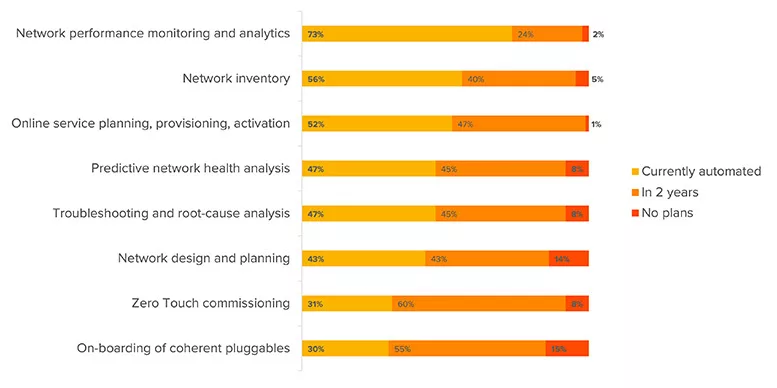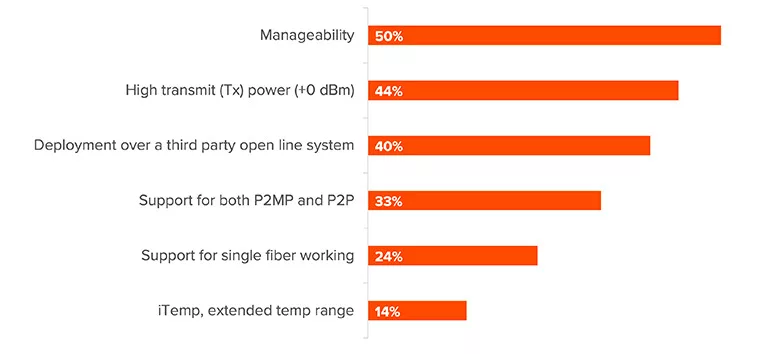Open optical networking (OON) is an increasingly popular networking approach where the optical terminals are decoupled from the line system, enabling operators to operate optical signals generated by transceivers from multiple vendors over a dense wavelength-division multiplexing (DWDM) open line system from a different supplier.
OON allows network operators to become more competitive, enabling vendor choice that supports a more resilient supply chain, faster access to innovation, and improved economics.
With a growing number of high-performance coherent optical pluggables on the market that can be equipped directly in switches and routers in IP over DWDM (IPoDWDM) deployments. These bypass the traditional use of transponders, streamlining architecture and lowering costs. It is part of a broader trend that sees optical networks evolving into diverse environments in terms of equipment vendors but also in terms of transport platforms.
However, some communications service providers (CSPs) are hesitating before embarking at scale on multi-vendor, multi-platform optical deployments, wary of potential operational complexity. This points to the need to simplify and unify the operation of an open optical network – specifically, with a management and control component optimised for these environments.
There are three types of deployment where software automation is successfully eliminating the sand in the gears of OON operations.
1. Following the open optical journey
Most CSPs I work with have started their open optical journeys in an exploratory way, deploying a few isolated transponders from a new vendor over an existing line system. Optical interoperability is not hard to achieve if the line system’s rules for transmitted optical power and spectral widths are met, and more so with open line systems offering modern link and power control algorithms.
When only a handful of optical channels from a second vendor are added, they can be configured and monitored manually. But as these deployments scale up, the introduction of a suitable vendor-agnostic management and control solution becomes mandatory. This type of software, an optical domain controller, handles all network elements that have the same function in a consistent manner, regardless of vendor, using common data models and well-defined southbound interfaces. It abstracts the network details, exposing its functionality through machine-to-machine northbound application programming interfaces (APIs) toward a hierarchical controller or other back-office and automation applications.
CSPs select optical domain controllers aligned with the latest open networking standards and industry initiatives in terms of architectures (eg TIP OOPT, ONF) and interfaces (eg OpenConfig, TAPI) to ensure wide compatibility, seamless integration, and readiness to evolve. CSPs on an open optical journey tend to adopt optical domain controllers in a phased manner:

- Initially, the optical domain controller is used to discover the multi-vendor network equipment and topology as well as its services, offering network-wide visualisation and supervision across transponders and line system under a single pane of glass. Most operators then proceed to integrate the open domain controller with their monitoring and inventory tools – foundational abilities on which network operators can build more complex automation, as seen in Figure 1.
- Next comes the creation of optical services. This is relatively easy to achieve for Layer 1 (ie multi-vendor transponder configuration), where standard device models are more mature and similar across vendors. While this functionality alone offers good value to CSPs, best-in-class optical domain controllers also offer end-to-end Layer 0 service provisioning of line systems, configuring all cross-connections along the optical path.
- The final step is comprehensive back-office integration, automating operator-specific workflows, including interworking with ordering systems, multi-layer network and service orchestrators, or even analytics and machine learning applications (most CSPs I talk to haven’t yet completed this phase – but the tools are there).
2. Mixing and matching transponders and pluggables
The increasing number of coherent optical pluggables from multiple vendors that can be equipped in routers is another driving force for open optical networking.

Internet content providers pioneered IPoDWDM with 400G ZR hosted in routers for short-distance data centre interconnect. The evolution toward more performant modules (Open ZR+, XR) enables pluggables in routers to connect directly to ROADM-based metro and long-haul networks. CSPs are starting to adopt IPoDWDM and identify manageability as a top priority when selecting pluggables (see Figure 2).
Additionally, when coherent optical pluggables in a variety of routers coexist in a network with transponders, all should follow the same management approach, sharing workflows, supported by a common software solution. Best-in-class optical domain controllers provide consistent vendor-agnostic control of optical pluggables and transponders alike, consolidating their data with that of the line system, taking us back to the journey above…
3. Open and yet resilient
As with any technology, there are open optical network trailblazers: operators who have not only adopted open optical networks, but require from them advanced functionality, such as restoration. Most optical restoration solutions today are implemented using GMPLS control planes, which, despite standardisation attempts, continue to rely on proprietary signalling mechanisms and do not work in multi-vendor environments. But alternatives exist: software-defined networking (SDN)-based restoration applications recently arrived on the market extend this functionality to open networks, making use of the optical domain controllers’ capabilities – multi-vendor network supervision, vendor-agnostic path computation, and service provisioning. A restoration application reacts to a network failure, typically triggered by a service-affecting transmission or equipment alarm, and orchestrates the restoration of all impacted services, deciding on new paths and then reconfiguring the required resources to recover traffic.
The perfect time to embrace network diversity
Open optical network field deployments are happening across multiple regions, with different degrees of complexity, and are scaling up with support from multi-vendor software solutions. As industry forums continue working toward convergence of control architectures and interface standardisation, the solutions on the market are maturing and successfully bringing to life increasingly advanced open networking scenarios. It is the perfect time to embrace network diversity with confidence.

Article by Teresa Monteiro is director of solutions marketing, network software and automation at optical networking company Infinera
Comment on this article below or via X: @VanillaPlus






